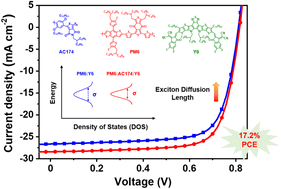Enhancing exciton diffusion by reducing energy disorder in organic solar cells†
Abstract
A highly crystalline, highly emissive, and wide-bandgap polymer AC174 with an extremely small Stokes shift is designed and synthesized in water, and is used to reduce system energetic disorder and increase the exciton diffusion length of the classical PM6:Y6 blend system. AC174 is incompatible with PM6 and Y6, improves molecular packing, and reduces system energetic disorder. The long-range Förster resonance energy transfer between the donor and acceptor is enhanced, and the exciton diffusion constant and exciton lifetime are increased, leading to a longer exciton diffusion length and more efficient exciton dissociation and charge generation. The addition of AC174 simultaneously improves the open-circuit voltage, short-circuit current density (JSC) and fill factor of PM6:Y6 devices; especially the highest internal quantum efficiency approaches 100%, and the highest JSC is 28.4 mA cm−2. Ternary devices with 5% AC174 in the donors achieve a power conversion efficiency of 17.2%, higher than those of the parent binary devices based on PM6:Y6 (15.9%) and AC174:Y6 (3.24%).

- This article is part of the themed collection: Honorary themed collection for Thomas P. Russell


 Please wait while we load your content...
Please wait while we load your content...